Tennessee is home to stunning hidden gems—cascading waterfalls tucked away from crowded tourist spots. These secluded spots offer serene escapes, perfect for nature lovers and adventure seekers.
Unlike popular destinations like Fall Creek Falls, these lesser-known cascades provide quiet retreats. Some feature swimming holes, while others sit near historic sites or roadside pull-offs for easy access.
Photographer Chuck Sutherland captures their beauty, showcasing why they’re worth exploring. This guide covers practical tips, including trail details, seasonal conditions, and safety advice.
Table of Contents
Key Takeaways
- Tennessee has numerous off-the-radar waterfalls ideal for peaceful visits.
- Options range from easy roadside stops to challenging hikes.
- Many locations include swimming holes or historical significance.
- Photography opportunities abound at these scenic spots.
- Proper planning ensures a safe and enjoyable experience.
Why Explore Tennessee’s Hidden Waterfalls
Beyond the well-trodden paths lie cascades offering solitude and raw nature. These secluded spots provide an escape from bustling tourist hubs while showcasing the untouched beauty of Tennessee’s landscapes.
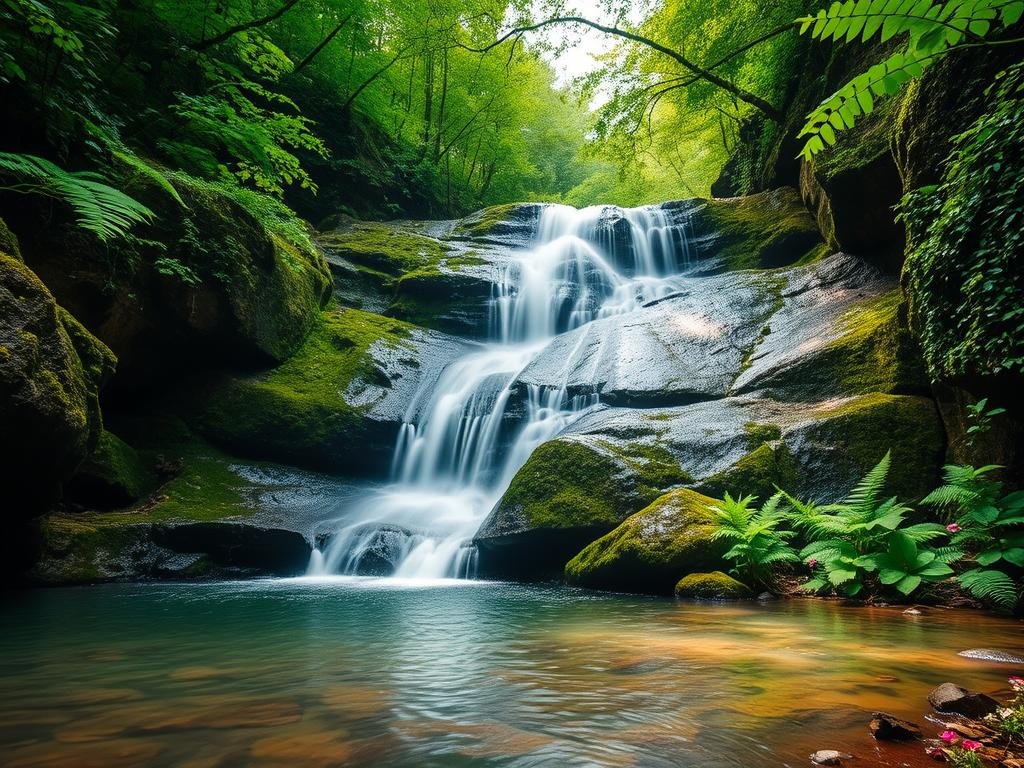
Escape the Crowds at Lesser-Known Gems
Popular destinations like Fall Creek Falls attract thousands annually. In contrast, spots like Cane Creek Cascades see only a fraction of visitors. This means quieter trails and uninterrupted views.
Fewer people also help preserve delicate ecosystems. Minimal foot traffic reduces erosion and protects native plants. Many hidden falls feature unique microclimates supporting rare ferns and wildflowers.
Experience Untouched Natural Beauty
Secluded waterfalls often remain pristine, with crystal-clear pools and undisturbed surroundings. Places like Evins Mill’s Carmac Falls offer romantic backdrops, ideal for couples seeking privacy.
Photographers favor these spots for their natural framing and soft lighting. Without crowds, capturing long-exposure shots or wildlife encounters becomes effortless.
| Feature | Popular Waterfalls | Hidden Waterfalls |
|---|---|---|
| Visitor Traffic | High (500+ daily) | Low (under 50 daily) |
| Trail Conditions | Worn, marked | Natural, less maintained |
| Photography Potential | Limited by crowds | Uninterrupted angles |
Whether seeking adventure or tranquility, these lesser-known falls deliver unmatched experiences. Pack light, respect the environment, and enjoy the serenity.
Waterfalls Near Nashville for a Quick Getaway
Just a short drive from Nashville, breathtaking cascades await those seeking quick outdoor escapes. These falls blend accessibility with natural beauty, making them ideal for day trips or photography excursions.
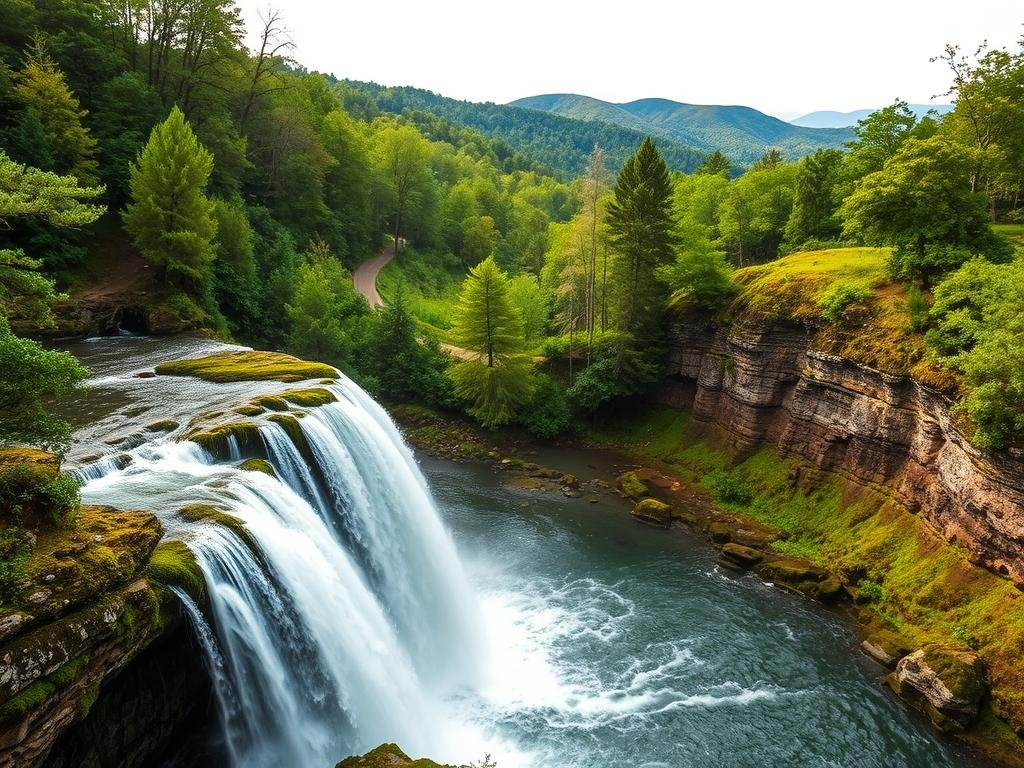
Cane Creek Cascades: A Serene Photo Spot
Located 110 miles from downtown Nashville, Cane Creek Falls offers tranquil pools and moss-covered rocks. Photographers love framing shots using its natural ledges, especially during golden hour.
The area requires no permits, but parking is limited. Arrive early to secure a spot and enjoy the peaceful ambiance.
Machine Falls: A Loop Trail Adventure
Closer to the city (65 miles), Machine Falls features a 1.6-mile loop trail with rewarding views. Be prepared for slippery creek crossings—non-slip footwear is essential.
This hike suits moderate adventurers. The cascading water creates a misty backdrop, perfect for cooling off on warm days.
Jackson Falls: A Scenic Stop Along Natchez Trace
At milepost 404.7 on Natchez Trace Parkway, Jackson Falls cascades into the Duck River ecosystem. Its historical ties to early settlers add cultural depth.
The short walk from the parking area makes it accessible for all ages. Pack a picnic to savor the sounds of rushing water.
- Pro tip: Visit Cane Creek weekdays for fewer crowds.
- Machine Falls’ trailhead has restrooms but no water stations.
- Jackson Falls’ overlook provides wheelchair-friendly views.
Discover the Best Hidden Waterfalls in Tennessee’s State Parks
Tennessee’s state parks shelter some of the most breathtaking yet overlooked cascades. Beyond the iconic attractions, quieter trails lead to secluded falls with fewer visitors and pristine surroundings.
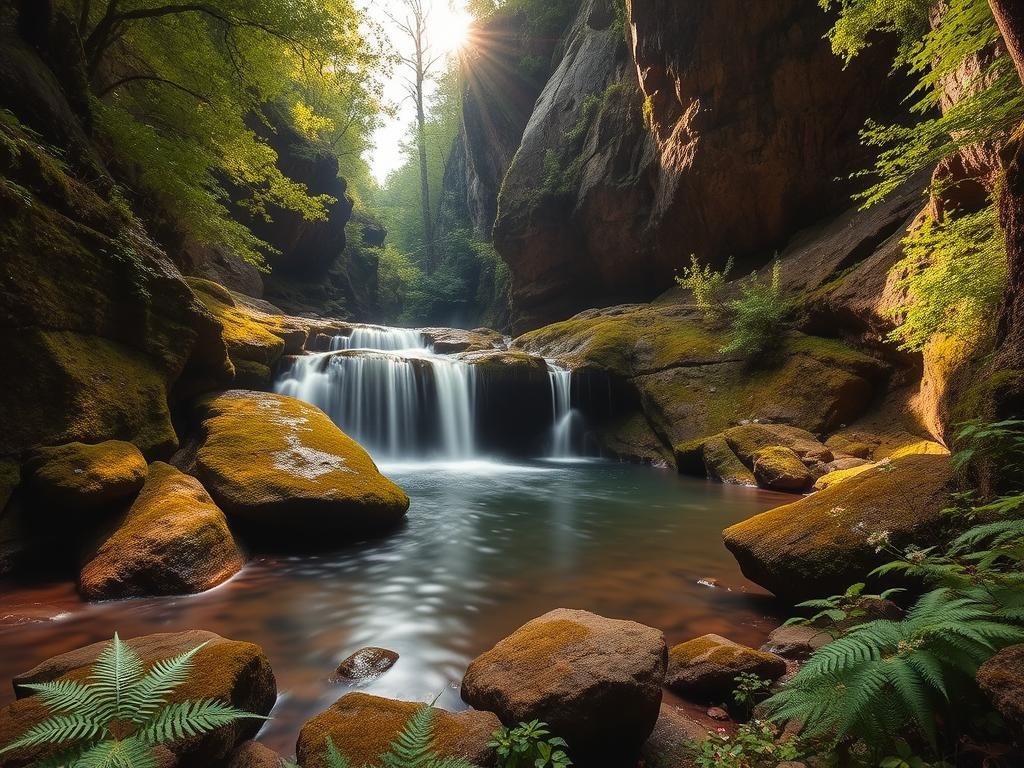
Fall Creek Falls State Park’s Secret Cascades
While the park’s namesake boasts a 256-foot drop, lesser-known falls like Cane Creek Cascades (GPS: 35.6608° N, 85.3565° W) offer intimate settings. Spring surges transform these tiers into roaring spectacles, while summer reduces them to delicate trickles.
Accessibility varies:
- Main falls: Paved paths and railings.
- Hidden cascades: Unmarked trails with natural terrain.
Ranger-led tours (seasonal) reveal hidden gems like Rockhouse Falls, ideal for photographers.
Rock Island State Park’s Twin Falls
Twin Falls, framed by steep bluffs, cascades into the Caney Fork River. The overlook trail provides panoramic views, but swimming is banned due to strong currents. Nearby Center Hill Lake offers safer swimming alternatives.
Key details:
- Best flow: March–May after rainfall.
- Trail difficulty: Moderate, with rocky sections.
- Photography tip: Use the natural limestone ledges as foreground elements.
Adventurous Waterfalls Near Chattanooga
Chattanooga’s surrounding wilderness hides thrilling cascades for adventurous hikers. These falls demand sturdy boots and route-finding skills but reward explorers with solitude and raw beauty.
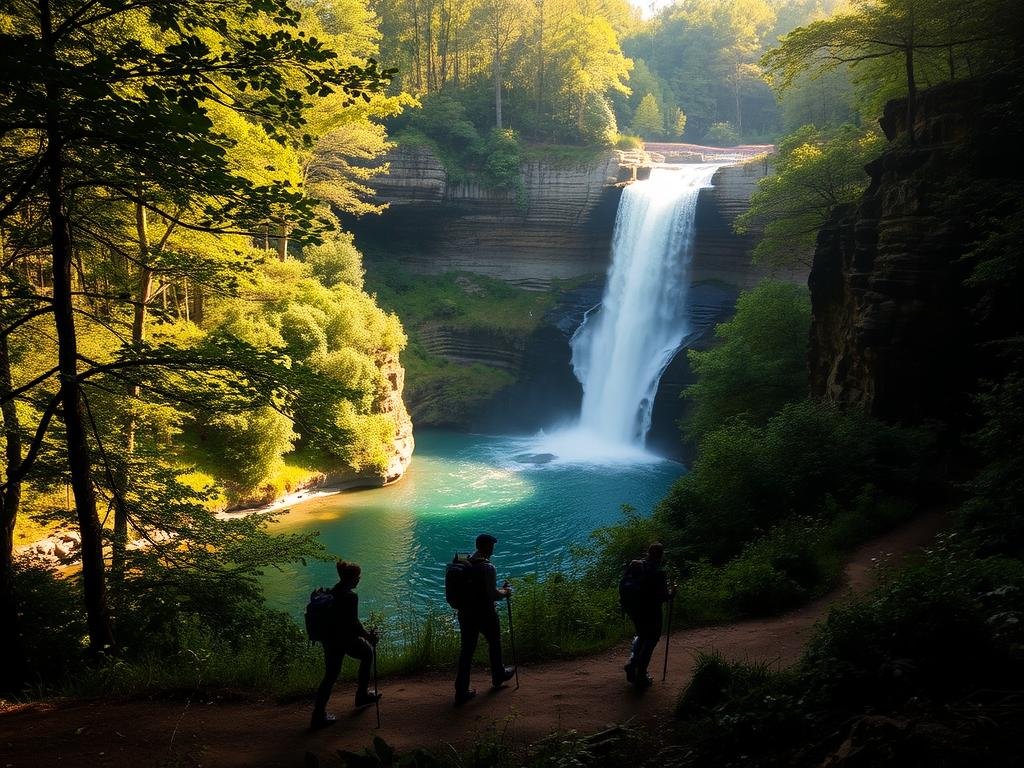
Middle Creek Falls: A Rugged Hidden Gem
Middle Creek Falls tests hikers with unmarked trails (YDS Class 3). Local guides recommend GPS or maps for navigation. Ancient rock formations frame the cascade, creating a dramatic backdrop.
Key tips:
- Route-finding: Scout landmarks like bent sycamores near the creek.
- Footwear: Wear ankle-supporting boots for slippery rocks.
- Wildlife: Watch for river otters in the pools below.
Conasauga Falls: Seclusion in Tellico Plains
Conasauga’s 1.2-mile uphill return hike (YDS Class 2) leads to a 40-foot cascade. The climb requires hydration packs—no water sources exist along the trail.
Geological wonders include 500-million-year-old quartzite outcrops. Birders often spot peregrine falcons soaring above the falls.
Waterfalls with Historical Significance
History and hydrology collide at these lesser-known falls, each with a unique legacy. From ancient carvings to pioneer tales, these cascades offer more than just scenic views—they’re windows into tennessee’s past.
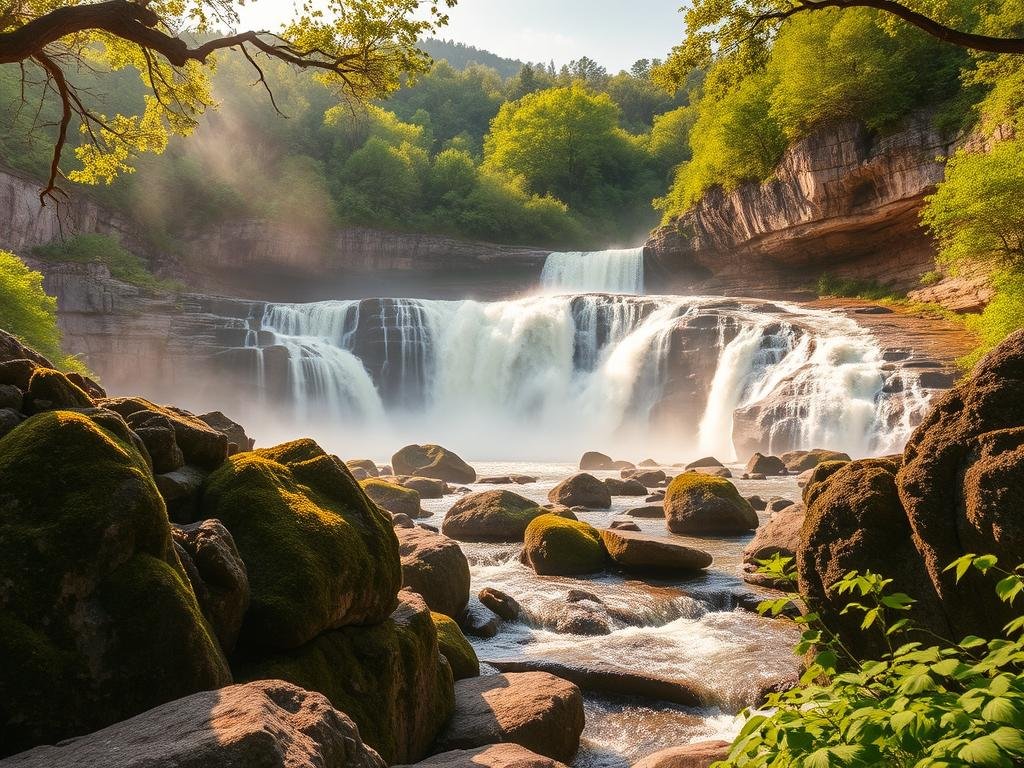
Old Stone Fort State Park’s Ancient Wonders
This park protects 1,500-year-old Native American artifacts near its cascades. Waterfall carvings suggest ceremonial use, while the surrounding earthworks reveal advanced engineering.
Visitors today can explore:
- Guided tours detailing archaeological finds like stone tools.
- Self-guided trails linking waterfalls to ceremonial sites.
- Preservation rules—no climbing on fragile rock carvings.
Falls of Jericho: A David Crockett Legacy
Spanning 8,900 acres, this site was a hunting ground for frontiersman David Crockett. Nineteenth-century journals describe its roaring falls as a landmark for early settlers.
Key features include:
- A rugged 4-mile round-trip hike to the main cascade.
- Seasonal ranger talks on Crockett’s historical expeditions.
- Strict leave-no-trace policies to protect the ecosystem.
Plan a day trip here to walk in the footsteps of legends—just pack sturdy shoes and respect the land’s cultural weight.
Waterfalls Perfect for Swimming
Cool off in Tennessee’s natural swimming holes beneath cascading waterfalls. These spots blend adventure with relaxation, offering crisp pools to dive into after a hike.
Cummins Falls: A Refreshing Oasis
This 75-foot cascade requires permits, released 30 days in advance. Summer visits reward swimmers with a turquoise plunge pool, but check flow rates—safe levels are under 250 cfs.
Morning visits avoid bacterial blooms. Local outfitters rent waterproof phone cases for underwater shots.
Greeter Falls: Dive into Turquoise Pools
Greeter’s 50-foot drop lands in a stunning blue basin. A spiral staircase leads to the swim area, but rocks are slippery—water shoes are a must.
Weekdays offer quieter swims. The nearby picnic area makes it ideal for day trips.
- Safety first: Avoid swimming after heavy rains; currents double in strength.
- Permit tip: Cummins releases 15 slots/hour—book at 8 AM sharp.
- Gear up: Rent GoPro mounts at Burgess Falls Outfitters.
| Waterfall | Safe Flow Rate (cfs) | Best Swim Season |
|---|---|---|
| Cummins Falls | Under 250 | June–August |
| Greeter Falls | Under 180 | May–September |
Waterfalls Accessible with Minimal Hiking
Not all stunning cascades require long hikes—some offer breathtaking views right from the roadside. These spots cater to families, seniors, and anyone short on time but eager to experience Tennessee’s natural beauty.
Bald River Falls: Views from the Road
Bald River Falls dazzles visitors with its 90-foot drop, visible from a paved pull-off on Forest Service Road 126. No hiking needed—just park and enjoy.
Key features:
- ADA-compliant viewpoints with safety railings.
- Parking fits RVs under 25 feet; arrive early for peak-season spots.
- Golden hour (sunrise/sunset) enhances photography without extra gear.
Ozone Falls: A Quick Walk to Majesty
Made famous by Disney’s The Jungle Book, Ozone Falls rewards visitors after a 0.3-mile walk. Its 110-foot plunge into a mossy grotto feels worlds away from civilization.
Plan your visit:
- Trailhead includes benches and picnic tables—ideal for seniors.
- Combine with nearby Crab Orchard Museum for a low-effort day trip.
- Weekday mornings offer solitude for uninterrupted shots of the falls’ majesty.
Multi-Tiered Waterfalls to Marvel At
Tennessee’s geology crafts dramatic multi-tiered waterfalls worth exploring. These cascades plunge over layered rock formations, creating stunning visual spectacles. Unlike single-drop falls, they offer varied viewpoints and unique photography angles.
Piney Falls: Upper and Lower Drops
Piney Falls features an 80-foot upper drop followed by a 40-foot lower tier. The trail winds through mist-fed cliffs adorned with rare moss species. Spring wildflowers like trillium dot the path, adding bursts of color.
Key details:
- Geological wonder: Formed by erosion-resistant sandstone layers.
- Drone use requires a park permit—apply online 72 hours ahead.
- Kayakers can launch downstream for a frontal view of both tiers.
Burgess Falls: A Triple Cascade Spectacle
Burgess Falls’ three-stage cascade drops 136 feet total. The final plunge into the Rocky River creates a roaring spectacle. A paved overlook trail suits all skill levels, while rugged paths lead to the base.
Planning tips:
- Best flow: April–June after spring rains.
- Kayak rentals available at nearby Fancher Falls Outfitters.
- Sunset lights up the falls’ spray for golden-hour photos.
| Feature | Piney Falls | Burgess Falls |
|---|---|---|
| Total Height | 120 feet (combined) | 136 feet (triple tier) |
| Trail Difficulty | Moderate (rocky sections) | Easy (paved overlook) |
| Unique Aspect | Ancient moss colonies | Kayak-access plunge pool |
Best Time of Year to Visit Tennessee Waterfalls
Timing your visit can make all the difference when exploring cascades in Tennessee. Each season transforms these natural wonders, offering unique experiences from roaring spring surges to autumn’s golden backdrops.
Spring Blooms and Peak Water Flow
March through May delivers the strongest flow, fueled by melting snow and spring rains. USGS data shows falls like Cummins and Burgess reach peak volumes, creating thunderous displays.
Wildflowers like trillium and mountain laurel bloom along trails. Check local bloom calendars for peak color weeks. Lodging discounts often apply during shoulder seasons.
Fall Foliage and Fewer Crowds
September to November brings crisp air and vibrant foliage. Reduced crowds mean quieter trails, ideal for photography. Use peak color prediction tools to time your visit.
Winter visits reveal icy formations, but tread carefully—many trails become hazardous. Always check park alerts for closures.
- Spring: Highest water levels; pack rain gear.
- Fall: Best for photos; book lodges early.
- Winter: Limited access; spikes recommended.
Essential Tips for Waterfall Hiking
Proper footwear and navigation tools make waterfall hiking safer and more enjoyable. Unlike standard trails, cascades often involve slippery surfaces and unpredictable terrain. Packing smart and knowing how to navigate hazards ensures a smooth adventure.
Footwear and Safety Gear to Pack
Choose footwear based on trail difficulty:
- Ankle-support boots: Essential for rocky or uneven paths (e.g., Merrell Moab).
- Water shoes: Ideal for crossings or swimming holes (e.g., Keen Newport).
Other critical gear:
- Trekking poles for balance on wet rocks.
- NOAA weather radio for real-time storm alerts.
- Compact first aid kit with blister pads and antiseptic.
Navigating Slippery Trails and Rocks
Wet trails demand caution. Use the AllTrails app to track your route and note hazard markers. Pro tip: Test footholds before committing weight—algae-covered stones are deceptively slick.
For remote falls, carry a satellite communicator (e.g., Garmin inReach). Local outfitters like Cumberland Transit rent gear near popular trailheads.
Leave No Trace Principles for Waterfall Explorers
Exploring waterfalls responsibly ensures these natural treasures thrive for future generations. Adopting Leave No Trace (LNT) principles reduces human impact while letting you enjoy the serenity of cascades.
- Pack out all trash: Even biodegradable items like fruit peels disrupt local wildlife.
- Use eco-friendly products: Opt for phosphate-free soap (e.g., Dr. Bronner’s) and reef-safe sunscreen.
- Observe wildlife from a distance: Never feed animals—it alters natural behaviors.
Fishing regulations vary by location. Check permits and respect protected species:
| Area | Permitted Fishing | Prohibited Species |
|---|---|---|
| State Parks | With valid license | Brook trout (protected) |
| Wilderness Areas | Catch-and-release only | All native mussels |
Join volunteer cleanups through organizations like Tennessee State Parks. These events restore habitats and educate visitors on sustainable principles.
Tennessee State Parks with Multiple Waterfalls
Tennessee’s state parks boast clusters of cascades waiting to be explored. These areas let visitors experience several falls in one trip, from gentle tiers to thunderous plunges.
South Cumberland’s Eight Hidden Cascades
The southern park’s trail system connects eight falls, including iconic Machine Falls. A multi-park pass ($40 annually) covers access to all sites. Rangers recommend starting early to visit at least three cascades in a day.
Backcountry camping requires permits, with group sizes capped at 12. Families can join waterfall passport programs—collect stamps at each cascade for junior ranger badges.
Savage Gulf State Park’s Seven Wonders
Savage Gulf’s crown jewel, Greeter Falls, features a spiral staircase to its base. The 12-mile Grand Rim Trail links six more cascades, each with unique geology. Guided tours (max 15 people) run Fridays from May to October.
Photography workshops focus on capturing layered falls like Boardtree Falls. Pack microspikes for wet-season hikes—limestone trails become slick.
| Park | Notable Falls | Best For |
|---|---|---|
| South Cumberland | Machine, Foster | Multi-day backpacking |
| Savage Gulf | Greeter, Boardtree | Day hikes with varied terrain |
Both parks showcase Tennessee’s natural wonders through well-maintained trails and educational programs. Check flow conditions online before visiting.
Capturing the Perfect Waterfall Photo
Waterfalls offer dynamic photo opportunities when captured with the right techniques. Whether using a DSLR or smartphone, mastering lighting and angles transforms cascades into stunning images.
Best Angles and Lighting Tips
Shoot during golden hour (dawn/dusk) for soft, warm tones. Position the sun behind you to highlight water textures. For silky flows, use a neutral density filter (e.g., Tiffen ND 0.6) to slow shutter speed.
Low angles near the pool’s edge create depth. Side profiles capture layered cascades, while overhead drones reveal hidden tiers. Avoid midday harsh shadows—cloudy days diffuse light evenly.
Using Natural Frames for Composition
Frame falls with overhanging branches or rock arches. Chuck Sutherland’s work showcases mossy ledges as foreground elements. The rule of thirds applies—place the cascade off-center for balance.
Smartphones can mimic DSLRs with manual mode (adjust ISO/shutter speed). For ethical shots, stay on trails and avoid trampling vegetation.
| Gear | DSLR Settings | Smartphone Tips |
|---|---|---|
| Long Exposure | f/11, 1/4 sec, ISO 100 | Use Night Mode + tripod |
| Action Shots | f/5.6, 1/500 sec, ISO 400 | Burst mode + HDR |
Pack weatherproof gear like dry bags and lens cloths. Check flow rates—higher water creates dramatic sprays but risks equipment.
Conclusion
Exploring cascades in Tennessee offers unforgettable adventure while connecting with nature. Remember to prioritize safety—check trail conditions and pack essentials like sturdy footwear. Respect leave-no-trace principles to preserve these gems for future visitors.
New spots like Piney Falls and Evins Mill’s cascades are gaining attention. For updates, visit TN State Parks. Share your favorite waterfall photos using #TNCascades for a chance to be featured.
Whether chasing roaring spring flows or serene autumn views, Tennessee’s falls deliver year-round wonder. Plan wisely, tread lightly, and let the water’s rhythm guide your next escape.

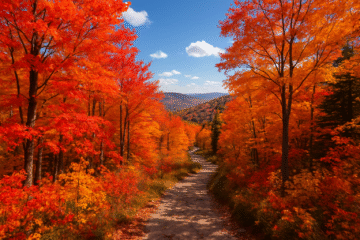

0 Comments